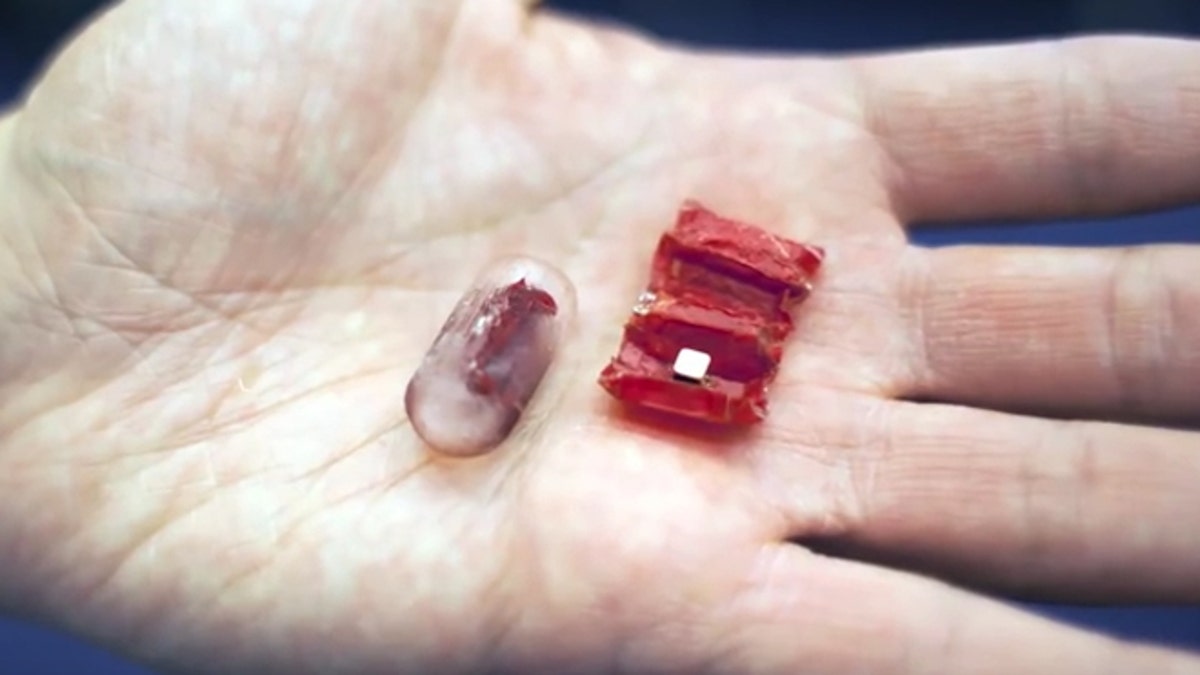
There likely aren't many occasions when you'd want to swallow a tiny robot. But what if such an ingestible bot could be put to work inside your body, targeting a foreign object or patching up an internal wound, before decomposing without a trace?
A team of researchers from the Massachusetts Institute of Technology has proposed a new, minimally invasive way of using biocompatible and biodegradable miniature robots to carry out tasks inside the human body. The design of the bots is inspired by origami, the Japanese art of paper folding.
Made primarily from dried pig intestines (commonly used for sausage casings), the tiny robots look like a cross between a caterpillar and an accordion. A tiny magnet allows them to be maneuvered by a tuneable external magnetic field, the researchers said. [The 6 Strangest Robots Ever Created]
The researchers have already demonstrated origami-inspired robots capable of swimming, climbing and carrying a load twice their weight, but creating an ingestible device that can operate inside a stomach presented a whole new set of challenges, said Shuhei Miyashita, who was part of the MIT team that developed the robot but is now a lecturer of intelligent robotics at the University of York in the United Kingdom.
"The toughest problem we had to solve was that of getting the robot to work in such an unpredictable environment," Miyashita told Live Science. "The robot design was re-created so that it can still walk when flipped upside down and can correspond to the change of the stomach anatomy."
Building a tiny bot
At the heart of the robot's layered structure is a material that shrinks when heated. When this happens, carefully placed slits cut in the outer layer cause the initially flat structure to fold into a series of box-like segments, the researchers said.
This design allows the robot to rely on so-called "stick-slip" motion, in which parts of the robot stick to a surface due to friction during certain movements, but then slip free when the weight distribution changes as the robot's body flexes.
But, because this particular robot is designed to work in a fluid-filled stomach, the team redesigned the robot to be more like a fin so that it also provides thrust by propelling water, effectively allowing the machine to swim as well as crawl.
"It is really important to see such small robots enable both actuation [or movement] and biodegradation," said Hongzhi Wang, a professor of materials science at Donghua University in China, who works on self-folding origami-inspired materials but was not involved with the new study. "It has great potential applications to health care."
Editor's Recommendations
- 11 Surprising Facts About the Digestive System
- Super-Intelligent Machines: 7 Robotic Futures
- 9 Odd Ways Your Tech Devices May Injure You
How it works
In a paper that was presented at the IEEE International Conference on Robotics and Automation, held May 16-21 in Stockholm, Sweden, the team from MIT's Computer Science and Artificial Intelligence Laboratory described how they created a synthetic stomach to test the device and devised a two-step process for hypothetically removing a watch battery that had been swallowed. The scientists also demonstrated how the robot can patch the wound the battery leaves behind. [7 Weird Things People Have Swallowed]
A 3D-printed open cross-section of the stomach and esophagus was lined with a silicone rubber mold, which matched both the shape and physical properties of a real-life stomach. The synthetic organ was then filled with a liquid that simulated the properties of gastric fluid.
In the study, one of the robots was rolled up and encased in a pill-size capsule of ice. Once the device reached the stomach, an external array of metal coils created a magnetic field that interacted with the robot's magnet and could be tuned to make the capsule roll toward the ingested watch battery.
The magnet causes the capsule to attach itself to the battery and when the robot rolls away again, it dislodges the battery from the stomach lining. Both the robot and the battery are then naturally passed out of the digestive system, the researchers said.
A second robot is then ingested in the same way, but this time the ice is left to melt and the robot unfolds. The same magnetic array is used to guide the robot to the wound site, which the robot covers before it eventually dissolves. The robot's structure also includes a dissolvable layer impregnated with drugs designed to aid healing, the scientists said. Larry Howell, a professor of mechanical engineering at Brigham Young University in Utah, who works on origami-inspired mechanisms and medical devices, said the new research marks a valuable step forward in creating robots that can carry out medical procedures inside the body.
"The idea of ingesting the robot in an ice capsule for initial delivery, and having it be biodegradable so that it decomposes afterwards, has the potential of having reduced long-term impact compared to some surgical alternatives," Howell told Live Science.
Miyashita said it could be at least six to eight years before these robots reach the clinic, though. Control accuracy needs to be improved, he said, adding that rigorous animal and human testing will need to be conducted first.




















